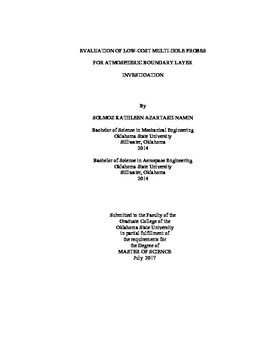| dc.contributor.advisor | Jacob, Jamey D. | |
| dc.contributor.author | Azartash-Namin, Solmoz Kathleen | |
| dc.date.accessioned | 2018-04-24T15:07:13Z | |
| dc.date.available | 2018-04-24T15:07:13Z | |
| dc.date.issued | 2017-07-01 | |
| dc.identifier.uri | https://hdl.handle.net/11244/299672 | |
| dc.description.abstract | This work presents the development of evaluating low-cost multi-hole probes (MHPs) for atmospheric boundary layer (ABL) studies. This concept is an integral part of CLOUD MAP, a National Science Foundation (NSF) funded grant led by multiple universities. CLOUD MAP stands for the Collaboration Leading Operational UAS Development for Meteorology and Atmospheric Physics and is focused on the development and implementation of unmanned aircraft systems and their integration with sensors for atmospheric measurements on Earth with the emphasis on Meteorology and Atmospheric Physics (MAP). MHPs are multi-dimensional mean-velocity measurement devices that measure pressure along a set of ports on the probe tip. MHPs are used in studies of from turbomachinery characterization, wake surveys, turbulence, ABL wind vectoring to determining the updrafts in smoke plumes. The accurate detection of sideslip angle in wind gusting is desired with MHPs. The current commercially available MHPs with sensor packages can run thousands of dollars indicating a need for highly accurate low-cost alternatives. Probes are designed using rapid prototyping methods through 3D printing and are evaluated through calibration testing. Probe tip geometry and internal tube dimensions give each probe different performance characteristics as no probe can be perfectly manufactured identically, and must all be calibrated once their lifespan in known testing flow regimes. This study addresses the development of testing platforms with a low turbulence subsonic wind tunnel as well as flight test sensor package development. Each probe is tested and validated through flight testing and comparisons with calibration curves. Standard non-nulling calibration and data reduction methods were used showing performance characteristics of each probe. Two geometries, hemispherical and pyramid, of multiple sizes are evaluated. Of the two geometry types, the hemisphere 5HPs produced the best quality pressure coefficient calibration curves with normal angular linear range between -25 to +25 degrees. Symmetry of these curves and the velocity curves indicate symmetry with the probes. A custom weather data sensor package has been developed for flight testing in ABL studies during the CLOUD MAP flight campaign. Further studies to determine print quality consistency, optimized probe designs, and furthering sensor development were examined and will improve overall accuracy and performance of these probes. | |
| dc.format | application/pdf | |
| dc.language | en_US | |
| dc.rights | Copyright is held by the author who has granted the Oklahoma State University Library the non-exclusive right to share this material in its institutional repository. Contact Digital Library Services at lib-dls@okstate.edu or 405-744-9161 for the permission policy on the use, reproduction or distribution of this material. | |
| dc.title | Evaluation of Low-cost Multi-hole Probes for Atmospheric Boundary Layer Investigation | |
| dc.contributor.committeeMember | Elbing, Brian R. | |
| dc.contributor.committeeMember | Conner, Joseph P. | |
| osu.filename | AzartashNamin_okstate_0664M_15384.pdf | |
| osu.accesstype | Open Access | |
| dc.description.department | Mechanical & Aerospace Engineering | |
| dc.type.genre | Thesis | |
| dc.type.material | text | |
